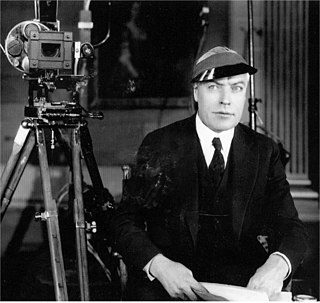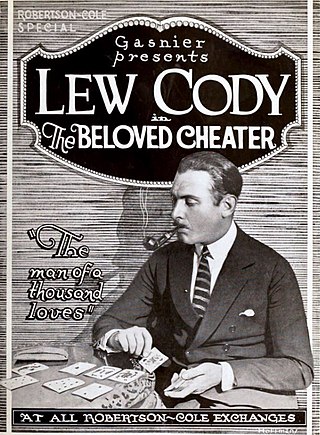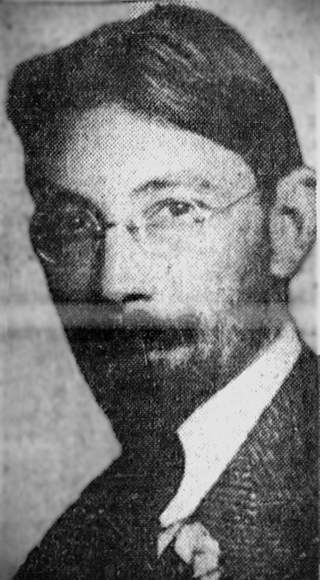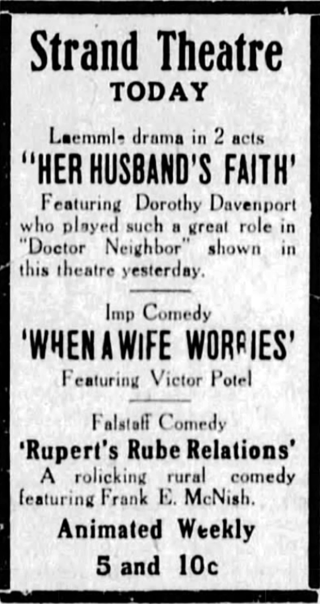The Motion Picture Patents Company, founded in December 1908 and terminated seven years later in 1915 after conflicts within the industry, was a trust of all the major US film companies and local foreign-branches, the leading film distributor and the biggest supplier of raw film stock, Eastman Kodak. The MPPC ended the domination of foreign films on US screens, standardized the manner in which films were distributed and exhibited within the US, and improved the quality of US motion pictures by internal competition. But it also discouraged its members' entry into feature film production, and the use of outside financing, both to its members' eventual detriment.
Ben-Hur or Ben Hur may refer to:
The year 1907 in film involved some significant events.

Sidney Olcott was a Canadian-born film producer, director, actor and screenwriter.
United States v. Paramount Pictures, Inc., 334 U.S. 131 (1948), was a landmark United States Supreme Court antitrust case that decided the fate of film studios owning their own theatres and holding exclusivity rights on which theatres would show their movies. It would also change the way Hollywood movies were produced, distributed, and exhibited. It also opened the door for more foreign and independent films to be shown in U.S. theaters. The Supreme Court affirmed the United States District Court for the Southern District of New York's ruling that the existing distribution scheme was in violation of United States antitrust law, which prohibits certain exclusive dealing arrangements. The decision created the Paramount Decree, a standard held by the United States Department of Justice that prevented film production companies from owning exhibition companies. The case is important both in American antitrust law and film history. In the former, it remains a landmark decision in vertical integration cases; in the latter, it is responsible for putting an end to the old Hollywood studio system.

Ben-Hur: A Tale of the Christ is a novel by Lew Wallace, published by Harper and Brothers on November 12, 1880, and considered "the most influential Christian book of the nineteenth century". It became a best-selling American novel, surpassing Harriet Beecher Stowe's Uncle Tom's Cabin (1852) in sales. The book also inspired other novels with biblical settings and was adapted for the stage and motion picture productions. Ben-Hur remained at the top of the U.S. all-time bestseller list until the 1936 publication of Margaret Mitchell's Gone with the Wind. The 1959 MGM film adaptation of Ben-Hur is considered one of the greatest films ever made and was seen by tens of millions, going on to win a record 11 Academy Awards in 1960, after which the book's sales increased and it surpassed Gone with the Wind. It was blessed by Pope Leo XIII, the first novel ever to receive such an honour. The success of the novel and its stage and film adaptations also helped it to become a popular cultural icon that was used to promote numerous commercial products.

Ben-Hur: A Tale of the Christ is a 1925 American silent epic adventure-drama film directed by Fred Niblo and written by June Mathis based on the 1880 novel Ben-Hur: A Tale of the Christ by General Lew Wallace. Starring Ramon Novarro as the title character, the film is the first feature-length adaptation of the novel and second overall, following the 1907 short.

Ben Hur is a 1907 American silent drama film set in ancient Rome, the first screen adaptation of Lew Wallace's popular 1880 novel Ben-Hur: A Tale of the Christ. Co-directed by Sidney Olcott and Frank Oakes Rose, this "photoplay" was produced by the Kalem Company of New York City, and its scenes, including the climactic chariot race, were filmed in the city's borough of Brooklyn.

Ben-Hur is a 1959 American religious epic film directed by William Wyler, produced by Sam Zimbalist, and starring Charlton Heston as the title character. A remake of the 1925 silent film with a similar title, it was adapted from Lew Wallace's 1880 novel Ben-Hur: A Tale of the Christ. The screenplay is credited to Karl Tunberg, but includes contributions from Maxwell Anderson, S. N. Behrman, Gore Vidal, and Christopher Fry.
Secondary liability, or indirect infringement, arises when a party materially contributes to, facilitates, induces, or is otherwise responsible for directly infringing acts carried out by another party. The US has statutorily codified secondary liability rules for trademarks and patents, but for matters relating to copyright, this has solely been a product of case law developments. In other words, courts, rather than Congress, have been the primary developers of theories and policies concerning secondary liability.

Robert G. Vignola was an Italian-American actor, screenwriter, and film director. A former stage actor, he appeared in many motion pictures produced by Kalem Company and later moved to directing, becoming one of the silent screen's most prolific directors. He directed a handful of films in the early years of talkies but his career essentially ended in the silent era.

Gene Gauntier was an American screenwriter and actress who was one of the pioneers of the motion picture industry. A writer, director, and actress in films from mid 1906 to 1920, she wrote screenplays for 42 films. She performed in 87 films and is credited as the director of The Grandmother (1909).

The Kalem Company was an early American film studio founded in New York City in 1907. It was one of the first companies to make films abroad and to set up winter production facilities, first in Florida and then in California. Kalem was sold to Vitagraph Studios in 1917.
Film rights are rights under copyright law to produce a film as a derivative work of a given item of intellectual property. In US law, these rights belong to the holder of the copyright, who may sell them to someone in the film industry—usually a producer or director, or sometimes a specialist broker of such properties—who will then try to gather industry professionals and secure the financial backing necessary to convert the property into a film. Such rights differ from the right to commercially exhibit a finished motion picture, which rights are usually referred to as "exhibition rights" or "public-performance rights".

Ben-Hur was an 1899 theatrical adaptation of the novel Ben-Hur: A Tale of the Christ (1880) by Lew Wallace. The story was dramatized by William W. Young and produced by Marc Klaw and A. L. Erlanger. The stage production was notable for its elaborate use of spectacle, including live horses for the famous chariot race. The hippodrama had six acts with incidental music written by American composer Edgar Stillman Kelley. The stage production opened at the Broadway Theater in New York City on November 29, 1899, and became a hit Broadway show. Traveling versions of the production, including a national tour that ran for twenty-one years, played in the United States, Great Britain, and Australia. By the end of its run in April 1920, the play had been seen by more than twenty million people and earned over $10 million at the box office. There have been other stage adaptations of Wallace's novel, as well as several motion picture versions.
Capitol Records, Inc. v. Thomas-Rasset was the first file-sharing copyright infringement lawsuit in the United States brought by major record labels to be tried before a jury. The defendant, Jammie Thomas-Rasset, was found liable to the plaintiff record company for making 24 songs available to the public for free on the Kazaa file sharing service and ordered to pay $220,000.

United States v. Motion Picture Patents Co. , 225 F. 800, was a civil antitrust prosecution overlapping to some extent with the issues in the decision in the Supreme Court's Motion Picture Patents case. After the trial court found that the defendants violated §§ 1 and 2 of the Sherman Act by establishing control over "trade in films, cameras, projecting machines, and other accessories of the motion picture business," by their patent licensing practices and other conduct, they appealed to the Supreme Court. After the Supreme Court's 1917 decision in Motion Picture Patents Co. v. Universal Film Manufacturing Co., however, the parties dismissed the appeal by stipulation in 1918 that the decision had made the defendants' appeal futile.

The Beloved Cheater is a 1919 American silent comedy film, directed by Christy Cabanne. It stars Lew Cody, Doris Pawn, and Eileen Percy, and was released on December 6, 1919.

Henry Christeen Warnack ) was a film and theater critic in the United States. He released novels and works of poetry. He crafted essays on a range of topics. Besides being a talented speaker, he got involved in the early film industry, scripting stories and Scenarios for various silent films.

Her Husband's Faith is a 1916 American silent short film directed by Lloyd B. Carleton. The film is based on a story by Paul Machette. Eugene De Rue developed the screenplay. This domestic society drama's features Dorothy Davenport, T. D. Crittenden and Emory Johnson.














